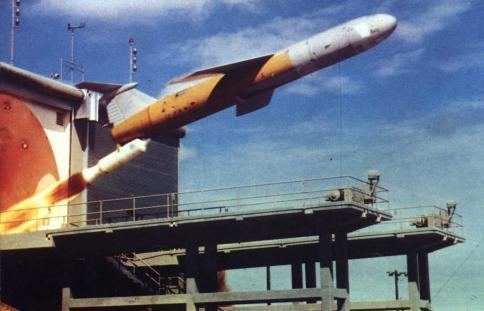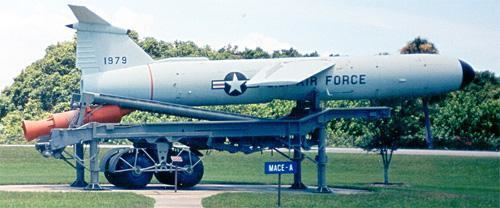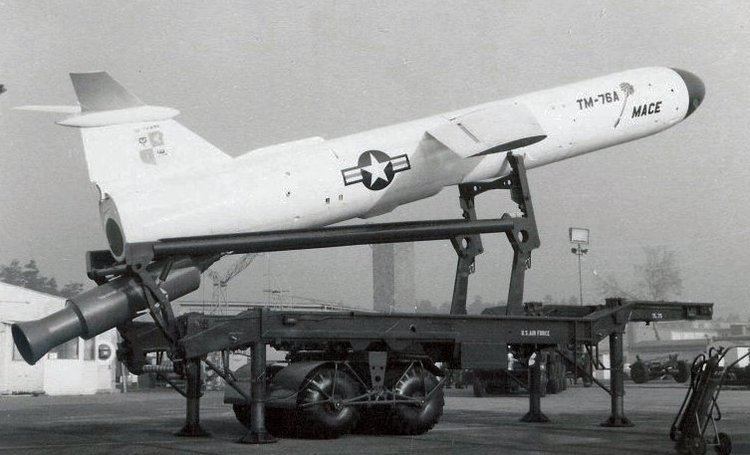Introduced 1959 First flight 1956 | Retired 1970 | |
 | ||
Mgm 13 mace cruise missile
The Martin Mace (designated as TM-76A and TM-76B tactical missile until 1963, then as MGM-13A for Mobile Ground Launched Missile and CGM-13 for Coffin Ground Launched Missile ) is a tactical cruise missile developed from the Martin TM-61 Matador later MGM-1 Matador. It was replaced by the MGM-31 Pershing missile by Robert McNamara, and later in its role as a cruise missile for West Germany, by the BGM-109G Ground Launched Cruise Missile.
Contents

History

Development began in 1954 as an improved version of the MGM-1 Matador. Like the Matador, the Mace was a tactical surface-launched missile designed to destroy ground targets. It was first designed as the TM-76 and later the MGM-13.

Mace MGM-13A was launched from a translauncher ( transporter erector launcher ) and the MGM-13B was launched from a hardened underground bunker using a solid rocket booster for initial acceleration and an Allison J33-A-41 turbojet for cruise flight. The Goodyear Aircraft Corporation developed ATRAN (Automatic Terrain Recognition And Navigation, a radar map-matching system) in which the return from a radar scanning antenna was matched with a series of "maps" carried on a 35mm film strip on board the missile. The ATRAN navigation section corrected the flight path if the missile deviated from the flight path as carried on the film map. In August 1952, Air Materiel Command initiated the mating of the Goodyear ATRAN with the MGM-1 Matador. This mating resulted in a production contract in June 1954. The ATRAN guidance system was difficult to jam and was not range-limited by line-of sight as in the older Matador radar command and control system, but its range was restricted by the availability of radar maps. In time, it became possible to construct radar maps from topographic maps.

The Mace was first launched in 1956 and the missile could reach Mach 0.7 to 0.85 over a 540-mile range at low level (as low as 750 feet), and 1,285 miles at high altitude. Development of Mace "B" missiles began in 1954, with the "B" having a longer fuselage, shorter wings, and more weight than the "A". In addition, the "B" included a jam-proof inertial guidance system (designated TM-76B), with range exceeding 1,300 miles. To enhance mobility, Martin designed the Mace's wings to fold for transport (the Matador's wings were transported separately and then bolted on for flight).
The USAF deployed the Mace in West Germany in 1959, and it served alongside the MGM-1 Matador before the latter phased out in 1962. Six missile squadrons served in Europe (38th Tactical Missile Wing) with just under 200 TM-61s and TM-76s. In South Korea, the 58th Tactical Missile Group became combat ready with 60 TM-61s in January 1959. It ceased operations in March 1962, only a few months after the 498th Tactical Missile Group in December 1961 took up positions in semi-hardened sites on Okinawa.
"B" missiles began were first deployed to Okinawa in 1961 and remained operational in Europe and the Pacific. The two squadrons of TM-76B/MGM- 13C continued on active duty in USAFE until December 1969. After being taken offline, some missiles were used as target drones because their size and performance resembled manned aircraft.
Variants
Survivors
Below is a list of museums which have a Mace missile in their collection:
Specifications
General characteristics
Engine
Technical information
Performance
Warhead
